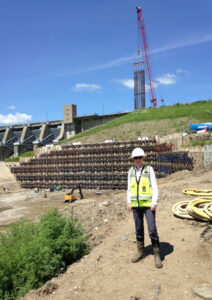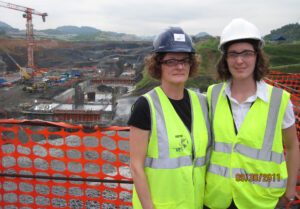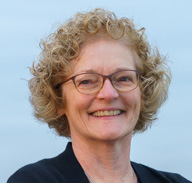When Denise Bunte‑Bisnett began taking her daughter Rachael with her on dam visits, it planted a seed of interest that would inspire Rachael to pursue her own career in hydropower. Since then, mother and daughter have both grown their roles in the world of dams: Denise is now the president of the board of directors of the United States Society on Dams (USSD), and Rachael is now a geotechnical engineer for Stantec. In this interview, they tell Hydro Leader about how they became involved in hydropower, their experiences as women leaders in the industry, and the importance of inspiring and mentoring the next generation of hydropower professionals.
Hydro Leader: Please tell us about your backgrounds and how you came to be in your current positions.
Denise Bunte‑Bisnett: I spent nearly my entire career working in the public power sector as a civil engineer. My first position was with the New York Power Authority (NYPA) on the St. Lawrence Power Project, following my grad school work on ice management on the river and river control operations. When my husband made a career change, we moved to South Carolina, and I began working with the South Carolina Public Service Authority, where I continue to work today. My first assignment was to assist with developing the license application for our relicensing effort. Most recently, I have focused on regulatory compliance and regulatory review, and now I am focusing almost entirely on getting our new Federal Energy Regulatory Commission license, an effort that has been ongoing for two decades.
Rachael Bisnett: I knew I wanted to be an engineer from a young age. Mom took me along to work with her at NYPA. In high school, I had an opportunity to participate in the Project Lead the Way engineering program, which was just starting at the time. The program was a good primer for the different fields of engineering, and it further solidified my desire to pursue an engineering career. I went to school at Purdue University and started out as a structural engineer. After a couple of summer internships, I realized structural really wasn’t for me, so I stayed at Purdue and earned a master’s in geotechnical engineering.
During my master’s studies, I applied for a USSD scholarship that gave me an opportunity to attend the USSD annual conference and network with professionals in the field of dams. There I met David Kleiner, who was one of the senior geotechnical engineers at Stantec (formerly MWH).
He encouraged me to stop by the office in Chicago the next time I was in town. That introduction led to an internship, which in turn led to a full-time position when I graduated. From the outset, I was involved in some really cool projects, such as the Panama Canal expansion and the Red Rock Hydro Project. Eventually, I was able to move back to the Southeast, where I focus on dam safety risk assessments.
Hydro Leader: Denise, please tell us about your role as president of the USSD board and your initiatives or goals for the organization.

Denise Bunte‑Bisnett: I am nearing the end of my term as president, and I am proud of what we have accomplished during my tenure. One of my early assignments was to help find our current executive director, Sharon Powers. Together, we were able to address some important issues, including the organization’s financial situation and members’ demands for better training and educational opportunities to help advance the profession.
In the last 18 months, we have focused on updating our strategic plan. We have primarily done this by refining the prior plan, which was developed about 7 years ago, by making it much more focused. That helped guide us through the pandemic year, which was a challenge for a lot of nonprofit organizations. Thanks to Sharon’s strong leadership and the financial position she had put us in prior to the pandemic, we came through the year quite well, remained strong financially, and became more robust as an organization. Sharon is focused on member outreach and making sure that our members understand the value of belonging to the organization. We have also put some programs in place to better position USSD to be a technical leader worldwide.
It has been a great experience to help lead USSD along with the rest of the executive team on the board of directors and with Sharon in the leadership role as our executive director. She is truly a professional nonprofit manager.
Hydro Leader: Rachael, would you tell us about your role in USSD as well?
Rachael Bisnett: I’ve worn a few hats over the last decade or so. I joined the organization as a student member when I was in college and quickly became a part of the embankment dams committee. I’ve been the chair of that committee since 2014. That has given me good insight into the organization and a lot of opportunities to network with some of the giants of our field, particularly in geotechnical engineering on the embankment dam side. When we revamped our website 6 years ago, I led the effort to stylistically and functionally bring it into the modern era.
Starting later this year, I’ll be leading our new initiative to create a speaker’s bureau. This program will give us another way to reach out to universities and to get our members into schools to share cool projects they’re working on, to help students think about dams as a career path, and to share information about what USSD is and what we do. We want to create stronger ties between universities and USSD with this program.
Hydro Leader: What has your experience been as women professionals in a male-dominated field?
Denise Bunte‑Bisnett: Early in my career as a junior engineer at a consulting firm, a client told me I was taking away a good job from a man who had a family to raise. It shocked me a little, but my manager handled it quite well and we moved on. Another manager early in my career felt uncomfortable having to travel for business with a female. Other than that, gender has never really been an issue with my coworkers, 99 percent of whom are men. I think engineers are pragmatic, and in general, we respect each other for our accomplishments and special knowledge. Gender rarely plays into it.
Rachael Bisnett: Early on, I always felt like I needed to work harder to differentiate myself. That wasn’t necessarily because of a message that I was receiving from my employer or those I was working with; it was just that because of life experiences or societal pressures, I felt I needed to prove myself. Later in my career, I spent about 18 months working on a construction site. There were definitely some nuances to being the only female engineer and oftentimes the only female on site. I have to say that 99 percent of those experiences were great. As you show your value, people respect you for what you bring to the table. That being said, I think you do occasionally run into bad situations or experience people making offhand comments. I don’t think that’s isolated to the engineering field; it is more reflective of society as a whole.
Hydro Leader: Rachael, your interest in engineering goes back to childhood. How did it begin?
Rachael Bisnett: My mom took me to dams a lot. We would take drives on the weekend, and more often than not, we’d end up at a nearby dam. I had the opportunity to go into work with her on a number of occasions. One memory that sticks in my mind is visiting one of the NYPA units that forms part of the project on the St. Lawrence River that is shared across the Canadian border while it was under maintenance. We went inside the unit and my mom was explaining to me how much water was being held up above my head. That was a really cool experience that solidified my interest.
I love building things, getting dirty, and playing outside, and geotechnical engineering has been a natural extension of that. The engineering program I participated in in high school demonstrated that engineering is fundamentally about solving problems. You can define the problem in whatever way is appropriate for the situation, but at the end of the day, you’re defining a problem and solving it. I think that really spoke to me. I’m able to put logic and structure into my work but also be creative and think about doing it a different or more efficient way. That is what led me to pursuing engineering in college and staying with it after college.
Denise Bunte‑Bisnett: When Rachael was deciding what to focus on in college, I recall the day she said, “I think I want to pursue engineering. You really love what you do, and I want to do something that I love to do also.” I think if people pursue what they love and enjoy solving problems and being creative, engineering is a perfect avenue.
Hydro Leader: Did you actively encourage Rachael to go into your field, and if so, do you have advice for how to get other young people interested in the dam engineering field?
Denise Bunte‑Bisnett: I took her to a lot of dams only because I am fascinated by them. We lived in northern New York when she was young, and there are a lot of dams on the Racquette River. Within an hour’s drive there were five or six dams, all different types of projects, that had been constructed around the 1950s. Rachael was naturally drawn to it and was always a strong student in math and science. I can’t say that I tried to push her into it. The important thing is for young people to be exposed to a lot of different things and to find out what really interests them and what they want to pursue.
Hydro Leader: Rachael, what is your advice for young engineering professionals?
Rachael Bisnett: First and foremost, it’s important to seek out organizations that will be invested in helping you continue to learn and grow. That doesn’t mean that there needs to be a formal mentorship program or anything like that—I’ve often found that those make mentorship a bit more challenging. My best mentoring relationships have come about organically, and I have a number of them for different reasons. The Chicago office where I started out was founded on the legacy of Harza, and the senior engineers there were intentional about teaching and training us to do things the right way so that we were in a good position to continue their legacies. A good teaching and learning culture is really important.

With that comes a lot of hard work. When you’re young and you have a bit more free time on your hands, take the opportunity to dive in and really understand what you’re doing. The better you understand it, the easier it’ll be in years to come. Take the opportunity to go on a field assignment, particularly if it’s a project that you worked on in the office. Those opportunities are rare. Seeing something in person, understanding how office decisions have affected how things are going in the field, and learning how it could be done better the next time are all crucial learning experiences for a younger engineer.
Also, I encourage young engineers to take opportunities to go somewhere or to take on roles that sound a little bit intimidating and challenging. Bet on yourself. Invest the time to figure out how to do it, even if that particular job or that particular role isn’t something you see yourself doing forever. You’re going to learn something from it that’s going to help you with the next experience.
Denise Bunte‑Bisnett: USSD now has a position on each of the technical committees for a young professional vice chair. The young professional committee is meant to be a landing spot for new engineers or younger professionals coming into our organization to help them get oriented and then move quickly into one of the technical committees. The technical committees provide opportunities to develop mentor relationships organically, because they allow you to meet with people, maybe in a social sense but also a working sense, through USSD.
Hydro Leader: Rachael, please tell us about your involvement with the Red Rock Hydroelectric Project.
Rachael Bisnett: I started working on that project about a year into my career, and I’ve been working on it for nearly 10 years now. I started as a junior engineer, and through the design process, I ultimately ended up as the lead geotechnical engineer during the design phase. I spent 18 months living in Iowa during the early geotechnical work, doing field and construction work. As a field geotechnical engineer, I got to see a lot of different things. We constructed structural diaphragm walls that currently form the left side of the approach channel for the intake structure and retain the upstream side of the existing embankment; there’s a maximum cantilever of about 59 feet embedded 35 feet or so in the rock. We also had some large, braced excavations to construct the intake structure on the upstream side and to construct two penstocks on the downstream side. We performed blasting within the downstream toe of the dam to form the powerhouse foundation. A bevy of cool geotechnical methods were incorporated in the project, and we were doing it all at an existing dam that we needed to ensure we didn’t harm. My onsite role also included dam safety, including performing weekly inspections, looking at instrumentation and monitoring, and interfacing with the regulators and our review board. During that time, I also took on the role of project technical lead, which means lead engineer for the construction phase of the project. Stantec has carried on engineering services during construction. It is currently finishing the commissioning of the project. It’s been sitting there, ready to go, since October of last year, but we had to wait until the U.S. Army Corps of Engineers could release enough water to finish commissioning. We’re close to completion, and while it’s definitely been a challenging project, it has been fulfilling and rewarding to see it from beginning to end.
Denise Bunte‑Bisnett is the president of the United States Society on Dams. She can be reached at denise.bunte-bisnett@santeecooper.com.

Rachel Bisnett is a geotechnical engineer at Stantec. She can be reached at rachael.bisnett@stantec.com.

